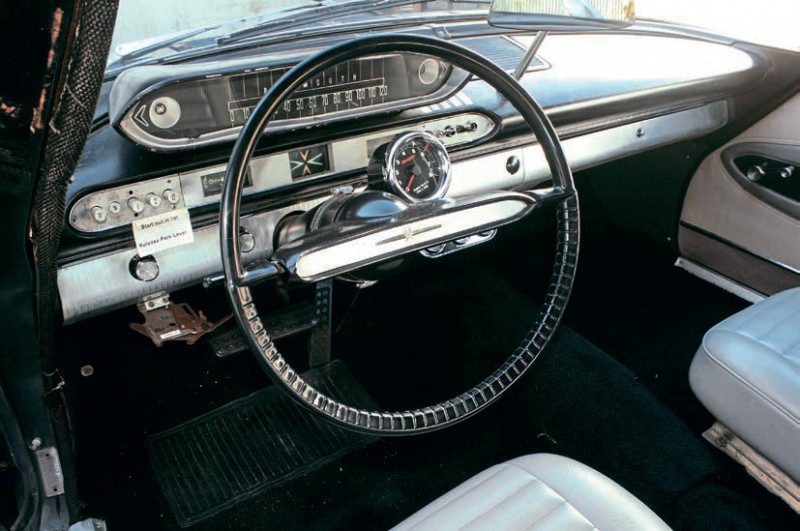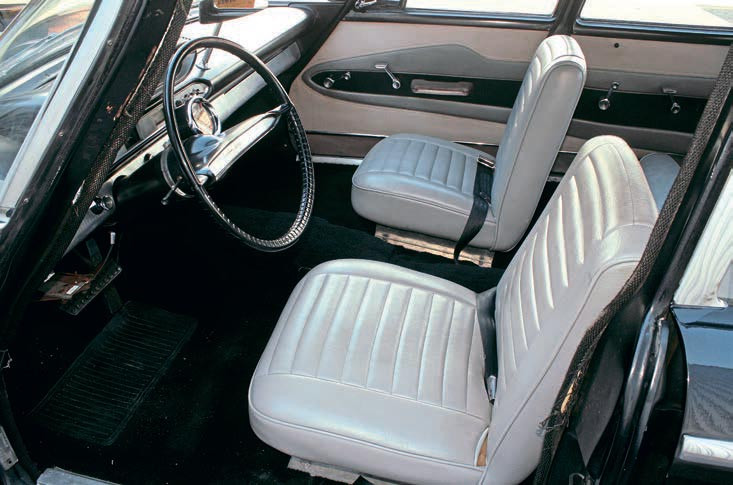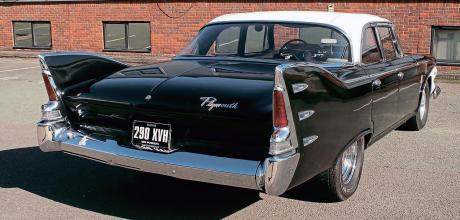1960 Plymouth Belvedere
Cars like this Plymouth Belvedere of Richard Mayo’s don’t come up for sale every day. From street car to race car and back, it could almost pass for a standard cruiser… until a peek under its bonnet reveals its monster motor!
Words and photography: Paul Bussey
WOLF IN SHEEP’S CLOTHING
Regular readers of Classic American will recall that we featured Richard Mayo’s 1959 Plymouth Fury and 1959 Plymouth Suburban station wagon last year. Being an avid fan of Plymouths produced between 1957-1961, collecting brochures, handbooks and general sales literature when space, time and money allowed, Richard jumped at the chance when the opportunity to purchase a 1960 Belvedere arose.

“For 1960, the most powerful engine option for the Belvedere was the new Sonoramic Commando with its 30-inch-long cross-ram inlet manifolds and two four-barrel carburettors, located against the inner wings,” explains Richard. “The sales brochure made this new engine look really wild, especially with flames coming from the exhaust ports in a beautifully painted illustration. This was a brave offering for a production vehicle and was only available for a couple of years. It was mainly used in Chrysler Letter cars, but could be specified in the Dodge, when it was known as the D-500 or the Plymouth Sonoramic Commando.

“Take-up was obviously low and very few have survived today. I was fascinated by this set-up and couldn’t imagine I would ever see one, unless I happened to be lucky enough to be at the right car show in the States at some point. Then one night when I was surfing the Words and photography: Paul Bussey net, I came across a four-door 1960 Belvedere for sale with a cross-ram set-up.” This obviously got Richard’s pulse racing. However, this was no ordinary Belvedere with the Sonoramic Commando engine; this car had been modified for drag racing and campaigned in Nostalgia Super Stock series in the US and despite its relatively standard exterior appearance, its technical specification was far from standard. The engine was a 400 block stroked to 470cu in with Mopar performance Aluminium 452 heads, competition 500CFM Carter carburettors, hydraulic roller cam, backed by a reverse pattern A727 transmission, still operated by the original push-buttons (!).

Cars like this don’t come up for sale every day and despite the ad having been placed some time ago, this didn’t stop Richard seeing if it was still available. It was, and he subsequently purchased it.
“Its owner and builder was Al Wilson and he proved to be a really friendly and helpful guy,” says Richard. “He got the car back into street trim for me, prior to me importing it from Florida to the UK in 2020. Things like fitting street tyres, windscreen wipers, lights etc., were all taken care of by Al. He had owned the car for a great many years and began racing it as far back as 2004. There’s some wonderful provenance and Al had purchased the Belvedere as long ago as 1990 and never thought he’d ever race it. Back then it was fitted with a 318cu in engine with a Powerflite transmission. Being a longtime drag racing enthusiast, Al eventually decided to race the Belvedere and fitted a big block of 451cu in engine, with a 727 push-button transmission in 2003, though at the time it was still a street car. He commenced racing in 2004 and continued right up until 2019, when his best ever time on the drag strip was 11.666 seconds over the quarter mile at 112.88, set in March 2019.

“The Belvedere is fitted with an 8¾ E body rear Detroit Locker, 3.55 gearing, has ESPO heavy-duty leaf springs, Caltracs traction bars, Calvert adjustable rear shocks, disc brakes front and rear, a Victory aluminium propshaft with safety hoops, transmits the power to the rear and a 16-gallon fuel cell is fitted in the boot. Apart from the wheels, some additional gauges, switches neatly replacing the heater push buttons and the front bench seat replaced by A990 style lightweight bucket seats, the car could almost pass for standard and there’s no roll cage fitted either. It’s also nice that the original Sonoramic Commando Power badges mounted on the front wings have survived intact.”
Al Wilson had developed the car over a good many years and its first run was at Huntsville Dragway on a 1/8th-mile track, where it achieved a time of 8.95 secs at 78.62mph on a test and tune session in April 2004, running on street tyres. After several cracked blocks over the years, the decision was made to fit a new block with a 470cu in stroker kit from Indy Cylinder in 2010, with the work completed by Damon Kuhn at Diamondback Engines.
Prior to that, the car had been driven to race meetings, but later was towed on a trailer. The new engine build, complete with Diamondback carburettors, put Al in the high elevens and comfortably in the NSS/E (12.0 index) as quick as he could go without a roll cage. There were plenty of significant finishes on various drag strips over the years, regularly racing in 60-carplus fields.
“My plan for the car was not to race it, but just to have fun on the street with this ‘wolf in sheep’s clothing’,” Richard explains. “I planned to change the front wheels for steels with dogdish hubcaps and thought about going back to a front bench seat if I can find one, to continue the illusion of a standard car. I was also considering fitting an A833 manual transmission with a Hurst shifter although Al, the builder of the car, with whom I am still in touch, has discouraged this. A huge set of invoices for all the speed upgrades came with the car, and it’s certainly been extremely well-built and developed using the best quality parts. Driving the Belvedere is always a thrill. Having primed the carburettors with a separate electric fuel pump, the engine starts instantly and is extremely loud, even without using the exhaust cut-outs.” You can hear the car coming from at least half a mile away or, depending on the direction of the wind, even a mile off! “The push in the back when you floor the accelerator seems unreal for such a big and standard-looking car and, when the situation demands, she can be very well-mannered, but always with a menacing, rough tickover,” continues Richard. “It’s not the most economic car I have owned, probably returning about 8mpg, but certainly the most exciting.”
This Belvedere may not be the easiest car to drive, but then it’s no longer a cruiser. A swift 20-minute blast is enough to blow away any cobwebs which may have accumulated and to release a fabulous adrenaline rush. While it’s fitted with the 727 three-speed automatic transmission operated by push buttons, ideally it should still be driven with manual changes in each gear, rather than auto. It has got so much torque, that often it’s not necessary to change down too often. There are a few do’s and don’ts which were advised by builder Al Wilson: don’t change into first gear when still moving, but it’s okay to change from third to second while on the move. Don’t do burnouts in first gear, use second gear.
Open the bonnet and you are greeted by the 470cu in stroker engine, the ram pipes (short ones on this engine) being a dominant feature and those gold-painted carburettor air filter housings. It’s an engine from a bygone time which has found its place in the annals of Mopar folklore. Many American cars from the Fifties were treated to the most fabulous ornate, beautifully sculptured and imaginatively styled dashboards, some being works of art, but the Belvedere’s elongated speedometer ‘pod’ doesn’t fit into that category. It looks to all intents and purposes like an afterthought and was just simply ‘plonked’ on top of the dashboard, not really befitting this fins ‘n’ chrome leviathan. Oh, well, you can’t win ’em all – and its monster motor more than makes up for any interior design shortcomings.
The story of this Belvedere and its transformation into a race car yet keeping as much originality as is practically possible is a remarkable one. It has provided previous owner Al Wilson with a most engaging, ongoing project, not to mention huge fun and notable achievements on the drag strip as its many awards will attest. However, after a great deal of soul-searching and being in the position, like a great many of us, of owning too many cars that we simply will never have enough time to drive on a regular basis, Richard recently came to the decision that his Belvedere had to find a new owner. It’s currently with avid American car enthusiast and dealer Andy Inglis.
“It was a very difficult and tough decision to make, but I knew ultimately that I wouldn’t be able to keep the car on a long-term basis, though at least I did own one of my Plymouth dream cars, if only for a short period of time,” remembers Richard, with a tinge of sadness…
On the strip. Courtesy NMCA Steve Wolcott Promedia Pub.
Racing stateside. Courtesy NMCA Steve Wolcott Promedia Pub.
Sonoramic Commando badging. Heater controls swapped for drag equipment.
A990 style lightweight bucket seats. Plymouth period ad. … a 470cu in motor with
Two x four-barrel carbs feed… 30-inch cross-ram inlet manifolds.
Plymouth’s tailfins reached their peak in ’60.


